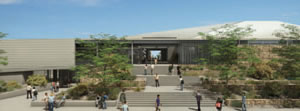Centralized Security Saves Time and Money

Identiv’s Hirsch provides centralized campus security for the growing Chandler-Gilbert Community College in Chandler, AZ.
Chandler-Gilbert Community College (CGCC) in Chandler, AZ, is a leader in the post-secondary education field. Recent figures from the Department of Education placed Chandler-Gilbert as the fastest-growing college in America. With a current headcount of 19,791 students, CGCC provides students with many excellent opportunities to help them realize their dreams.
With an annual budget of over $65 million, CGCC’s 935 employees work diligently to provide the very best in quality education, as well as keeping their students and staff safe. Identiv’s HIRSCH Velocity product provides critical control and centralized management of campus security for this growing college.
Managing electronic access to facilities across campus is key to CGCC’s security plan, as hiring full-time guards for all access points is cost-prohibitive. In the past, Public Safety staff would need to manually unlock each building with a key every morning. Now, Identiv’s HIRSCH Velocity provides centralized control and monitoring of facility access across the entire campus.
Unique challenges included older buildings that required special design attention during installation and the need for easily testable security lockdowns and lockopens in the case of an emergency. Without placing undue burden on the Public Safety staff, the first few buildings were brought online in 2007.
Facility access at CGCC is carefully controlled and monitored across 27 buildings, 183 acres and three campuses.
The benefits that Identiv’s HIRSCH Velocity product offers CGCC are numerous. The speed of access for access cardholders makes for a “frictionless” environment. Special purpose door openings and closings requiring Public Safety’s assistance are just a phone call away. With centralized credential management, CGCC anticipates supporting NFC-enabled phones and other devices to provide card-swipe access. Traditional cards with photo IDs may still be required in certain areas, including aviation hangar access. FAA-issued identification cards work seamlessly with Identiv’s multitude of available security protocols.
This article originally appeared in the issue of .